A game that usually has an important say in the title race became more one-sided than ever on Saturday night as Atlético Madrid kept up their credentials to stay just three points behind La Liga leaders Real Sociedad with two games in hand thanks to a victory over Barcelona at the Estadio Wanda Metropolitano.
Atlético Madrid won the tie thanks to Yannick Carrasco’s goal on the stroke of half-time, breaking forward and playing the ball between Marc-André Ter Stegen’s legs before slotting into an empty net. As will be outlined in this analysis, such counter-attacks were key to the Atlético Madrid game plan against Barcelona.
This tactical analysis of Atlético Madrid and Barcelona in their La Liga fixture will consider the tactics of Diego Simeone and Ronald Koeman in an analysis which underlines how Atletico Madrid ran out 1-0 winners.
Line-ups
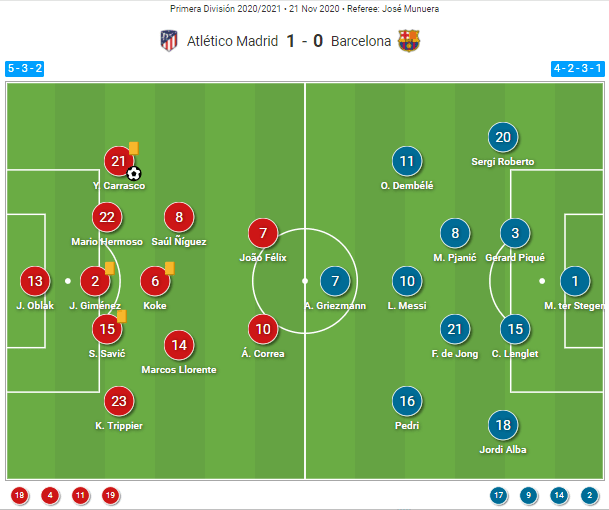
Atlético had to contend with some important absentees as Luis Suárez and Lucas Torreira were ruled out with Covid-19 caught while on international duty with Uruguay. Simeone opted to field Ángel Correa in attack with Carrasco and Marcos Llorente operating on either flank, with Mario Hermoso again preferred at left-back.
Koeman sprung no surprises with his selection, giving starts to Ousmane Dembélé and Miralem Pjanić in midfield due to injuries to Philippe Coutinho, who returned to the bench and came on as a substitute, and Sergio Busquets, who picked up a knee injury while on international duty.
Barcelona’s high line and poor positioning
Even for those who didn’t watch the game, you’re likely to have seen the calamitous Barcelona defending which led to Atlético’s goal, the only strike of the game. While question marks can undoubtedly be raised over Ter Stegen’s decision to come so far out of his goal, the blame really lies in the team’s defensive shape. With Jordi Alba in the final third on the left, Sergi Roberto stepped up to close down then backed off, with Piqué also stepping up to close down the breakaway from Atlético Madrid. Despite Frenkie De Jong’s best attempts, there was no way to track back and cover the space in time, leaving Clement Lenglet chasing and Ter Stegen rushing out to try to fill the gap. Carrasco deftly took the ball past him and was through.
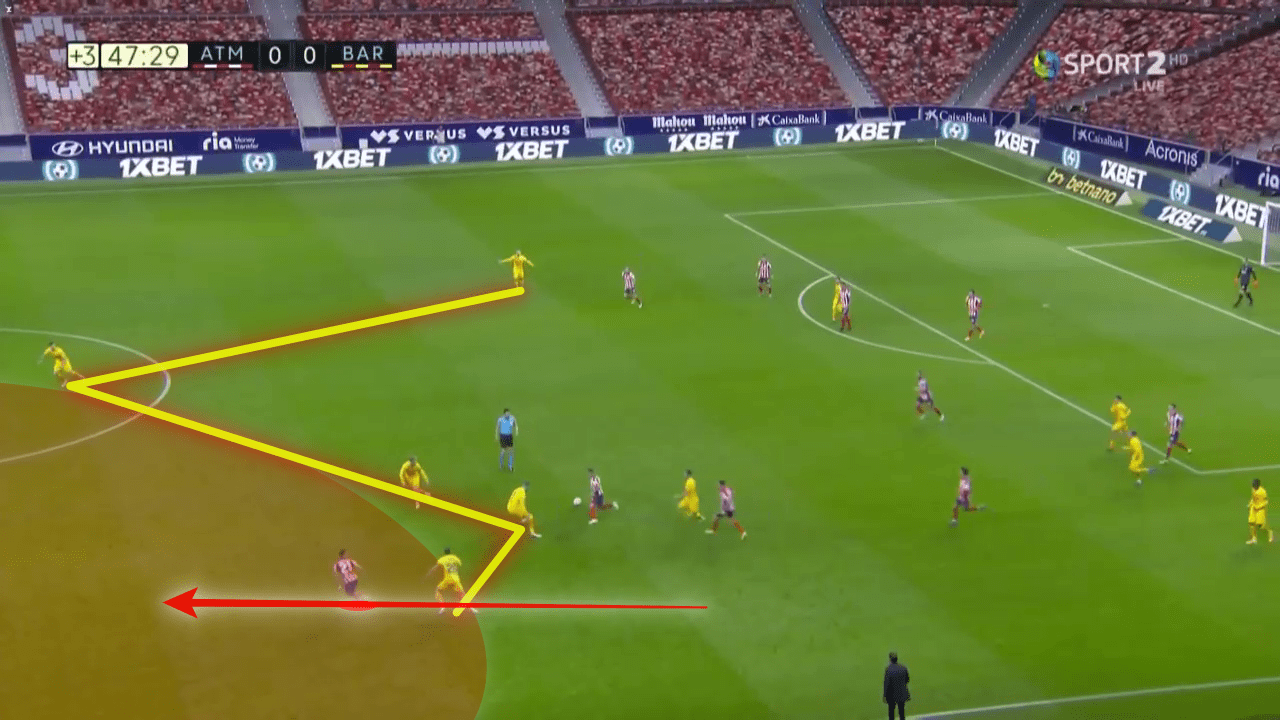
In other circumstances, it may be put down to being a moment of madness and a poor defensive error with concentration lacking so close to half-time. Such errors could be understood, but this was not just a single moment. In fact, just minutes earlier, a similar situation had arisen, and Barcelona were very nearly punished. Again, Sergi Roberto and Piqué stepped up, leaving a space in behind which Carrasco exploited with a run through the middle in behind Piqué. As can be seen below, there was a huge gap which opened up and allowed him through, though he mistimed his run and was very narrowly offside. Eight minutes later, he proved that he would not need another opportunity and didn’t make the same mistake again when gifted even more space to work with.
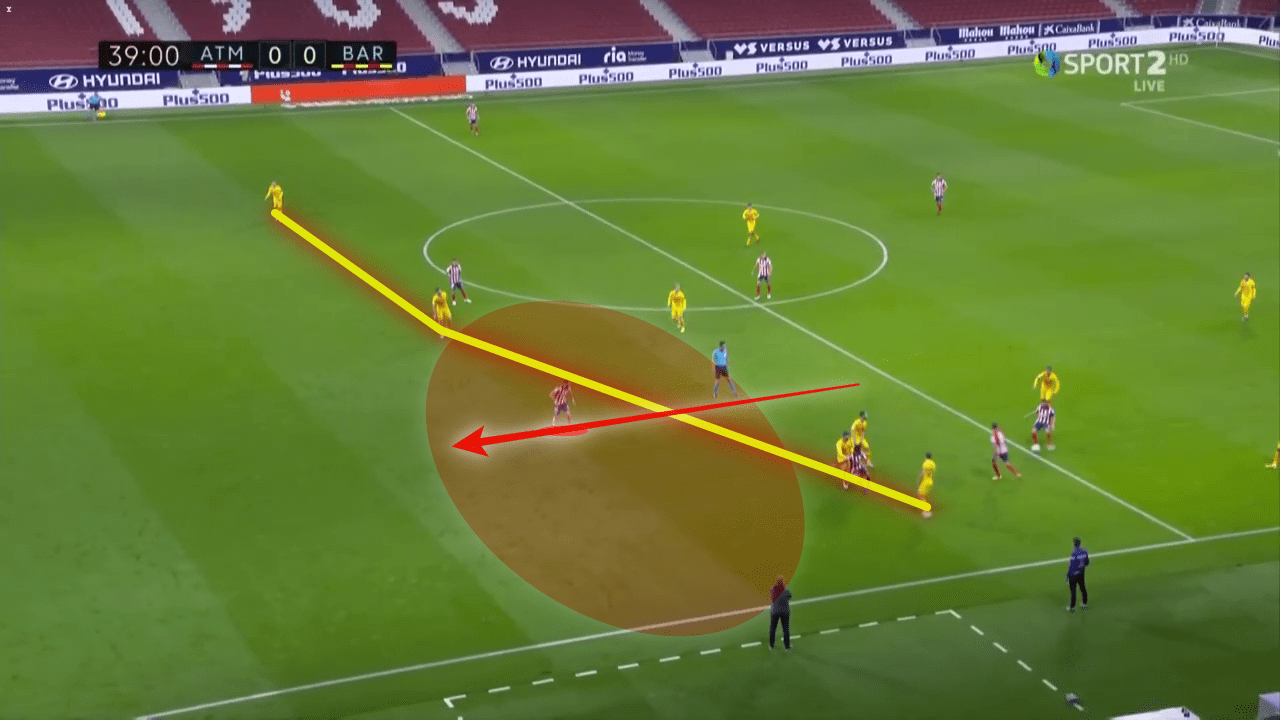
This reflected the way in which Barcelona gambled on playing with a very high line. In doing so, they sought to spread the game, with defenders offering the central options with more offensive players looking to make runs in behind the backline when in possession and press high when out of it. However, Simeone was well prepared for this eventuality, and it was clear in his team selection, overloading the side with pacey runners like Carrasco, Correa and Llorente who would be able to run into these holes which opened up in the Barcelona defence.
Koke’s free role and the Atleti midfield
Fundamental to making this offensive approach work was the role of Simeone’s captain, Koke. The midfielder has been in magnificent form of late, thriving with greater freedom. As can be seen in his heat map here, he was by no means playing in a disciplined and structured role in holding midfield. This is one of the changes which Simeone has made this season, in particular since the departure of Thomas Partey to Arsenal, which has allowed him to get more out of some of his players, Koke in particular. With the shackles off, he can roam more freely, covering impressive amounts of ground while attacking in wide areas and spreading play.
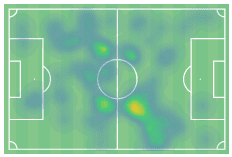
He primarily took up the deepest role within the midfield three, though at times he would drift further across to the right to provide cover for Llorente as he joined the attack. In this role, he operated almost like a quarter-back, looking to pick the ball up in deep possessions, spin and open up play with clearly pre-planned manoeuvres. His seven long balls all came from moves like this one below.
With the ball out wide and Barcelona pressing highly, Koke knows that his passing channel is blocked off. He moves into the space, closer to play, though he is aware that the pass won’t come directly to him. What it does do is distance him from Antoine Griezmann in a central position in order to be free to receive a pass from Hermoso.
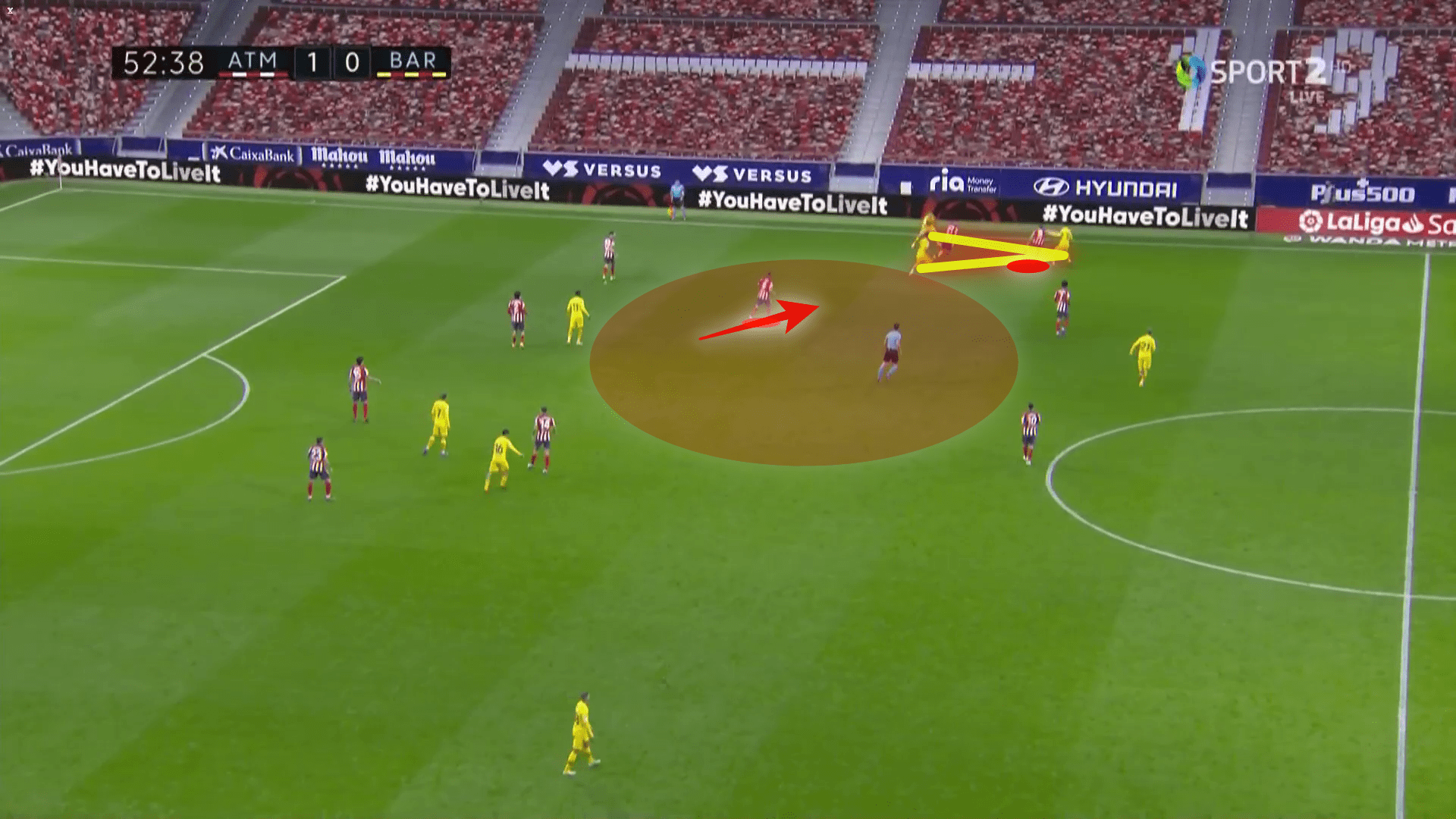
His quality then becomes evident as we can see that before Hermoso has even received the ball, Koke is already opening up his body position and spinning so as to receive the ball on his right side, ready for a one or two touch pass. This is evident of the change this season, contrasting to the slow and turgid build-up play which had become commonplace under Simeone. Instead, Koke was looking to take the ball from defence to attack as soon as possible.
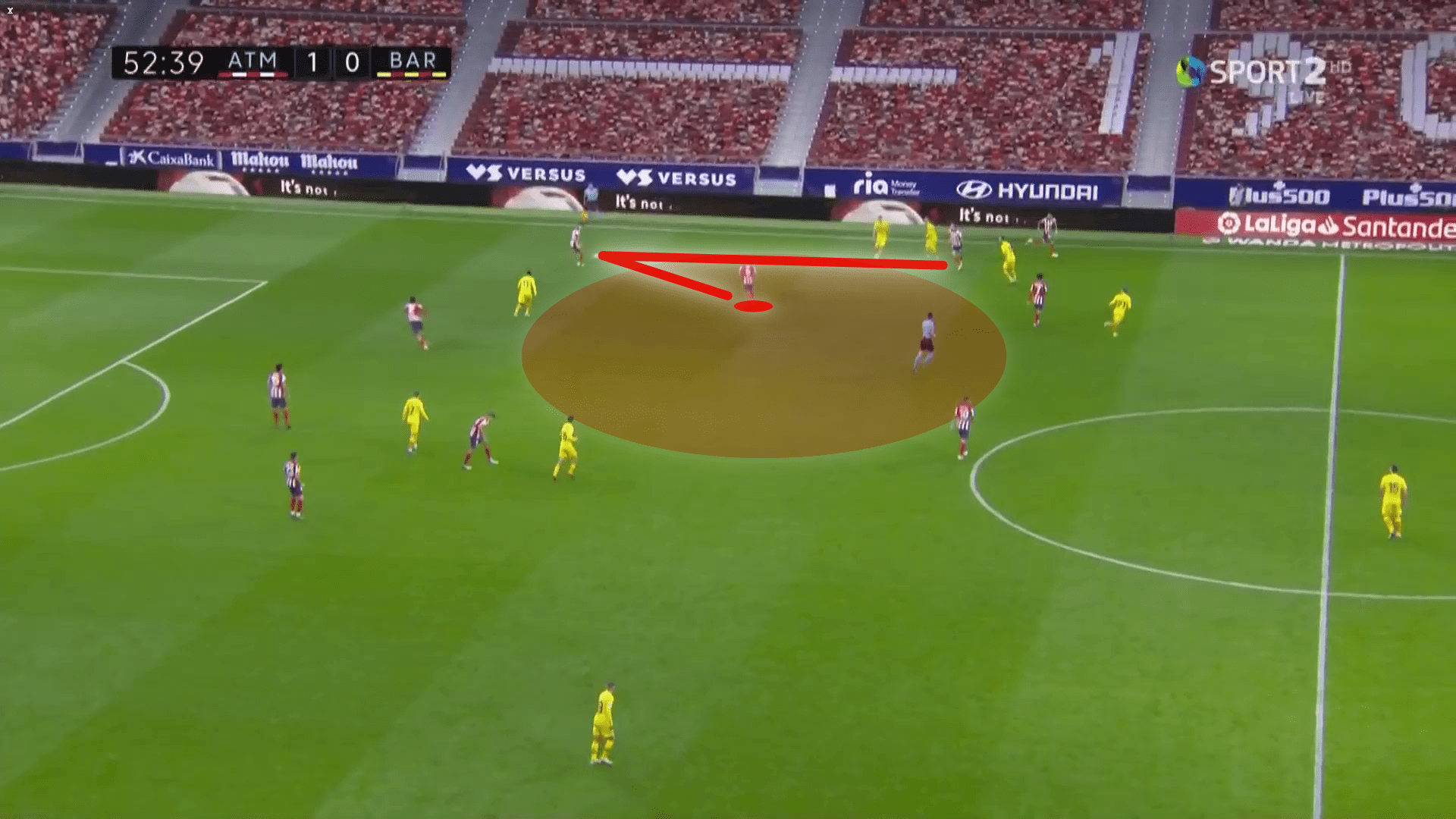
After driving forwards, we can then see how Carrasco is exploiting the run down the left. With Roberto having stepped up to press, he was left free and with a headstart in the sprint. Koke would drive forwards and play the pass over the top, not only creating a dangerous threat, but also removing a man from the equation in the centre where Piqué would be forced to drift across to cover for the full-back. This also made it easier for the likes of Correa or Félix to compete in the final third.
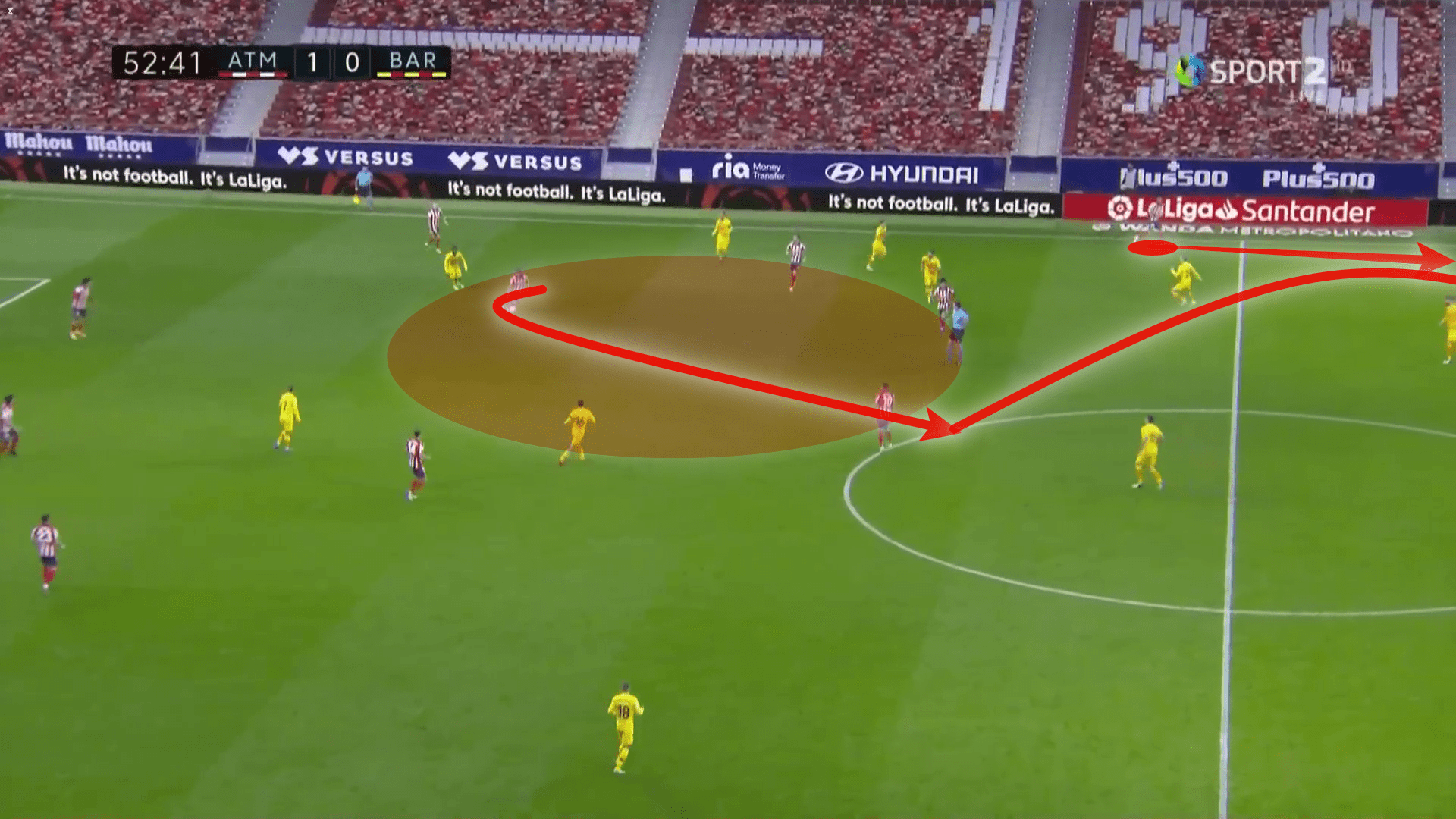
This just goes to show the importance of the Atlético Madrid captain within his team’s set-up. Criticised regularly in 2019/20 for lacking pace and energy, this season the new role is allowing him to demonstrate just those two traits. He has now taken the reigns and is dictating the pace of play in midfield. With over 93% passing accuracy, he is a man who Simeone can rely on to take up such a role.
Marcos Llorente taking on Jordi Alba
While this analysis has so far focused heavily on the way in which Atlético Madrid exploited Barcelona’s high press and poor positioning, the best way in which Atleti exploited this was actually on the opposite flank, on their right. Barcelona were less vulnerable on this side, with Lenglet and Jordi Alba more disciplined in their positioning, but it was a frequent point of attack. This was in part due to the link-up play between Kieran Trippier and Llorente. It was actually the most frequent passing combination in the Atlético squad with 27 passes between the two. Llorente took advantage too, making five dribbles, four of which ended in a shot or cross into the box, with a 100% completion rate for his nine forward passes throughout his 76 minutes.
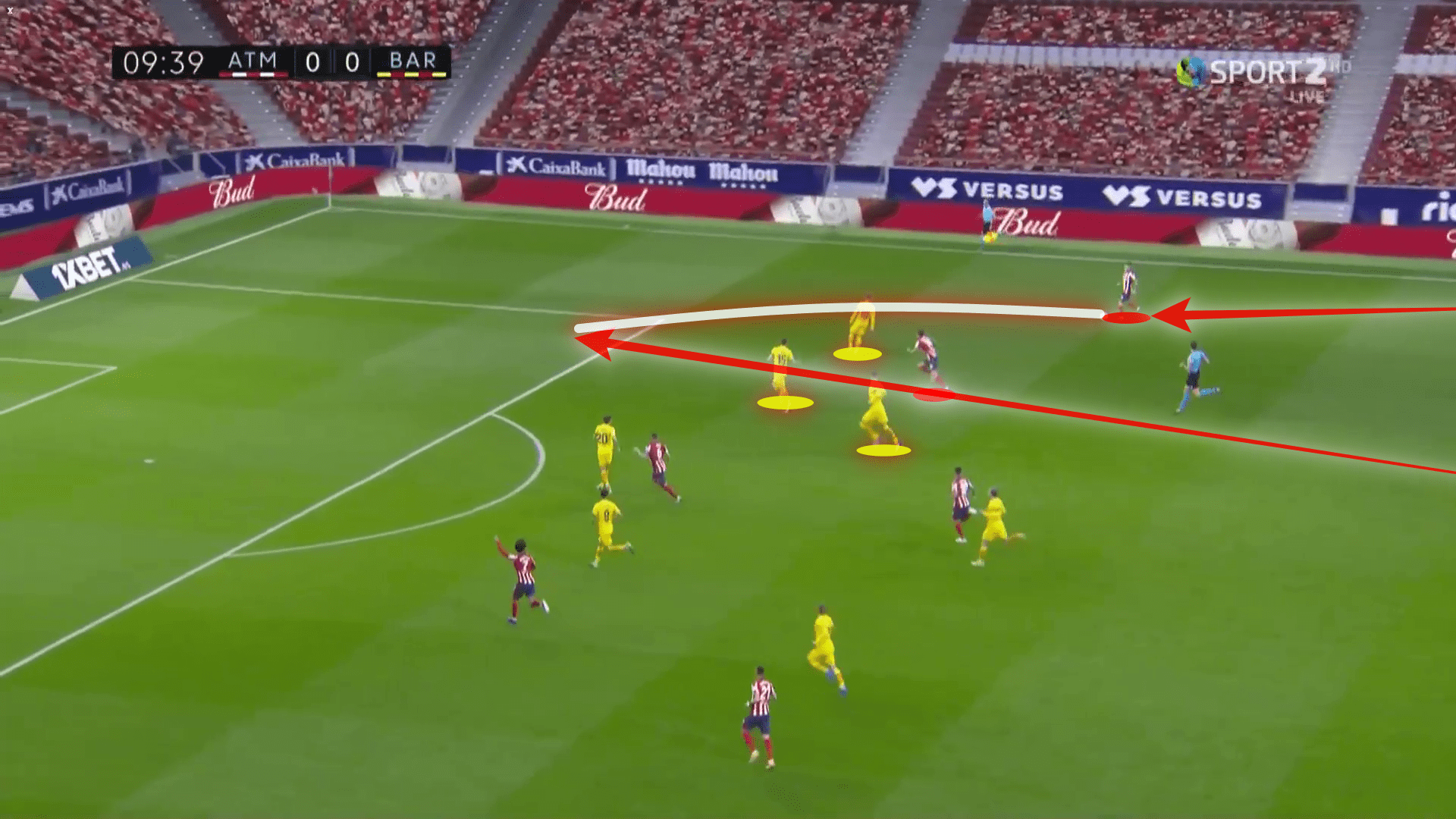
As can be seen above, Trippier would bring the ball forward from deep, while Llorente would move from a more central area to exploit the space between Lenglet and Alba. Aware that he would not be tracked by midfield runners, he could do so with his physicality to produce explosive late runs which Trippier picked out time and time again. It was a deadly tactic, particularly early on, leading to Barcelona taking action after Llorente hit the crossbar.
From around 35 minutes onwards, Koeman took measures to prevent this tactic from being so powerful. Their solution was to look to cut off the move at its source by implementing a high press to push Trippier and keep him positioned in his own half. Unable to get out of that space, he would be unable to pick out Llorente’s runs through the middle and would instead be forced to play backwards or to Llorente on the touchline, a much easier proposition to defend against.
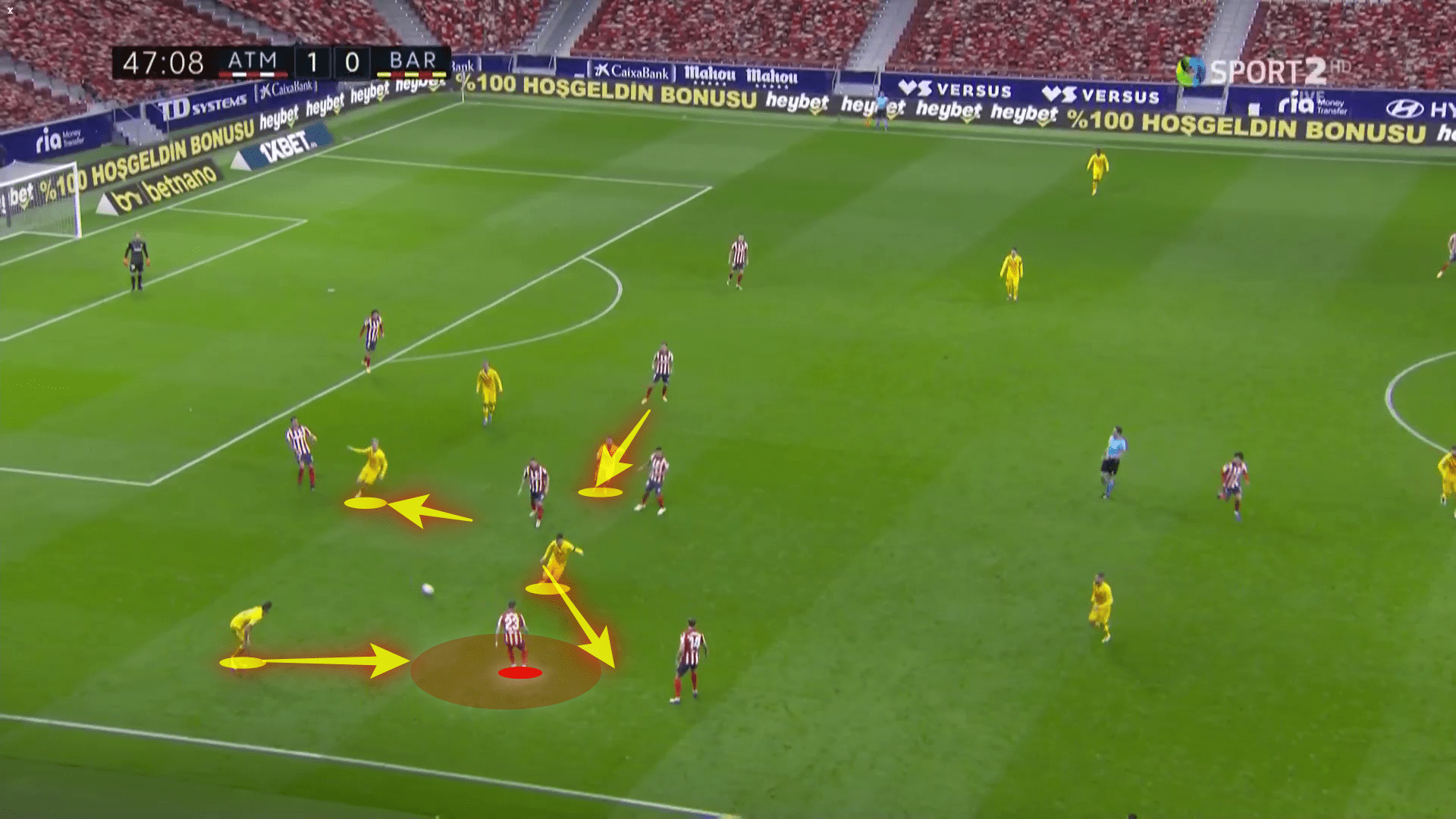
The approach from the Catalans did work. This was evident as the remaining 55 minutes accounted for 76.5% of possession losses between Trippier and Llorente, making Trippier more sloppy in possession as he looked to find a way out. By congesting play in this way, Barcelona kept Atlético under control, but they also overcommitted and made it easier for Koke to spread the ball to Carrasco on the opposite flank.
Barcelona’s lack of fluidity
Defensive concerns have been on show throughout this season since Koeman took charge. Looking to implement more energy and a higher press in attack, they become more vulnerable at the back. However, the more concerning factor at the Wanda Metropolitano was undoubtedly the way in which Barcelona struggled to create opportunities and looked so blocked with their attacking play.
In part, this was due to the role of Lionel Messi. With a team-high of 10 losses, Barcelona continued to rely upon their number 10 to create chances despite his continual possession losses, though it is worth noting that this is the lowest such figure for Messi since the Champions League defeat to Juventus. Rather than finding and creating spaces, he would too regularly fall into the Atlético traps of shepherding him into central areas and then surrounding him by blocking off his passing channels. This, combined with a lack of movement around him, made it hard for the Argentine.
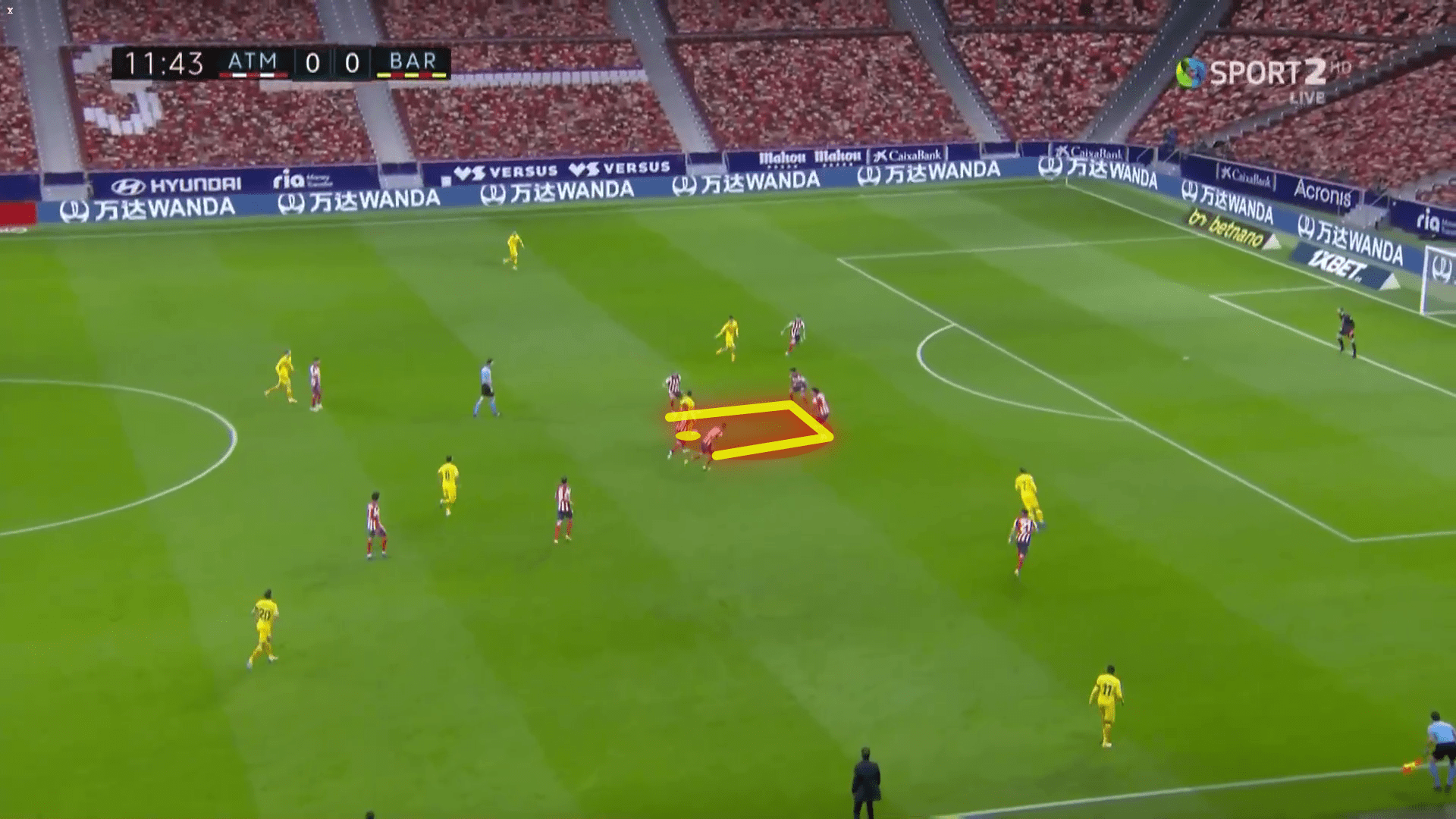
Even with this in mind, Messi still accounted for 40% of smart passes from his team. With Atlético able to drop deep into a defensive structure which at times had as many as eight players, with Correa and Félix pushing higher up, they were able to man-mark the Barcelona front four out of the game. The biggest threat was Dembélé, the only player with enough pace to disrupt such a defensive set-up.
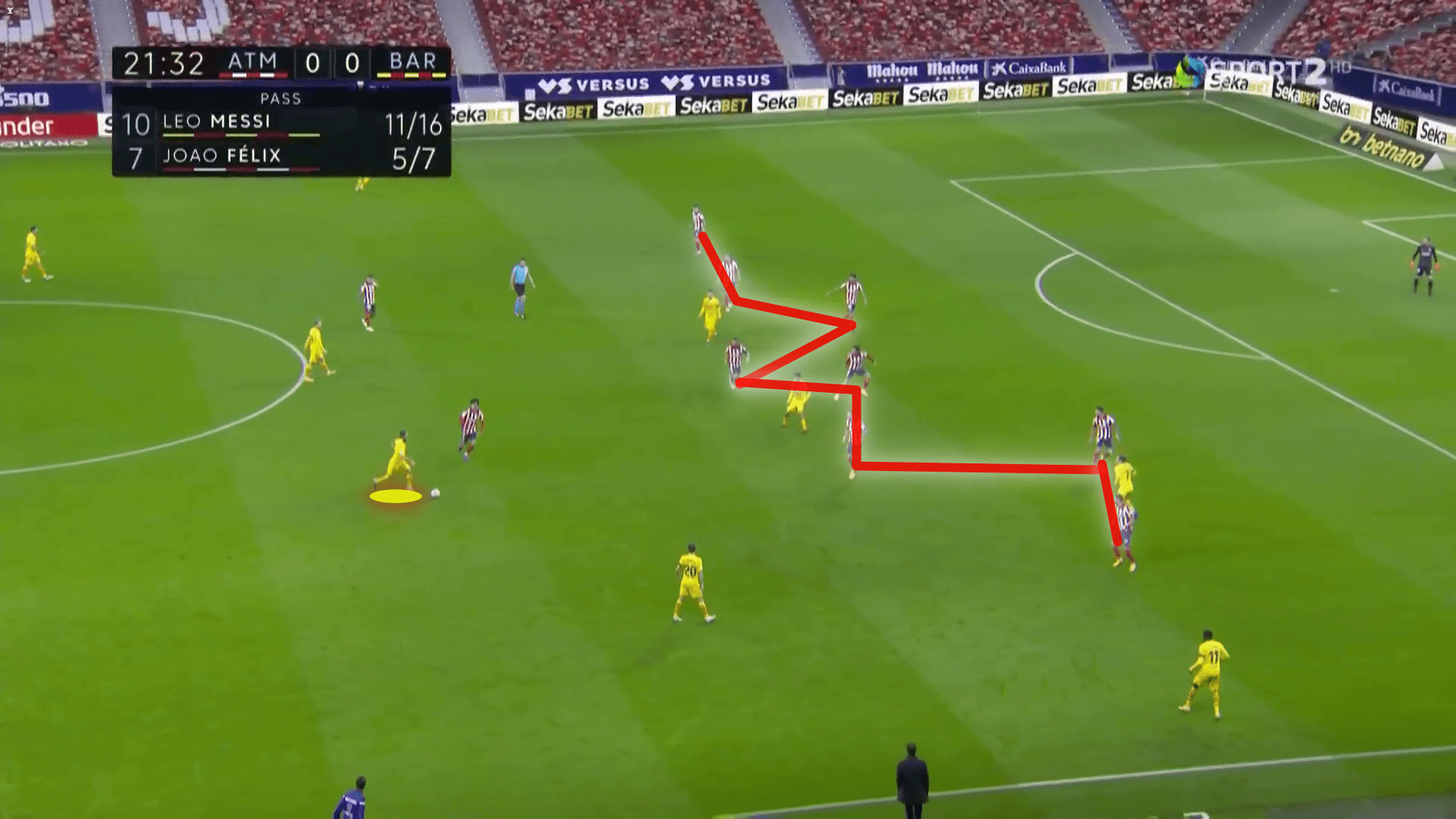
Barcelona found that Pedri and Dembélé would be wide on the touchlines, with Griezmann and Messi again treading on each others’ toes in central areas. With Atleti able to drop the midfield three and allow their front two to press any Barcelona player in possession, they could effectively nullify the Barcelona set-up, and Koeman was unable to change his team’s strategy quickly enough, or significantly enough, in order to create any real change in how they performed in an offensive sense.
Conclusion
What this analysis shows us, more than anything, is that Simeone was the far better-prepared coach of the two. What he then did was to react better than Koeman too. With a clear tactic of looking to bomb the flanks and attack spaces which were left in behind by Barcelona defenders, Carrasco and Llorente formed a key part of his game plan, and Koke’s performance in central midfield helped to exploit that with his passing range.
Barcelona failed to adapt, not helped by defensive injuries, and looked devoid of ideas in attack. Their failure to change their strategy meant that while it was a defensive error which led to Atlético’s goal, it was one which could easily have been avoided if it were not for repeating the same defensive flaws which allowed Atlético to attack the same mistakes until they could turn them into a difference on the scoreboard.
Atlético will feel buoyed that their approach was so clinical, looking sturdy in defence and intelligent in attack, but Barcelona will have major concerns which will only be reinforced by injuries to Sergi Roberto and Piqué. If one of these sides is to be leading the title race at any point this season, it doesn’t look likely to be the usual suspects from Barcelona.





Comments